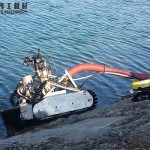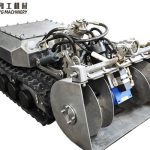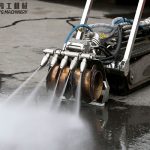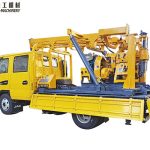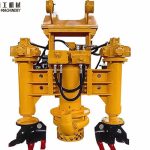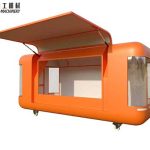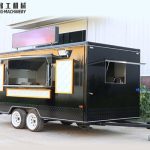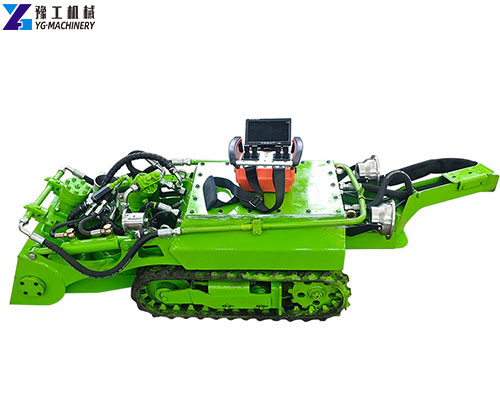

Have you ever seen a robot that can work in water? Today, I’ll introduce you to an amazing dredge remote robot, also known as a dredging remote-controlled robot. It looks a bit like a miniature armored vehicle, with a sturdy outer shell that allows it to work in various complex underwater environments, unaffected by water corrosion. Its “body” has wide tracks, like tank tracks, which allow it to move steadily on silt without getting stuck. At its front, it’s equipped with various dredging tools, some resembling large shovels, others like powerful water guns. The dredging remote-controlled robot is mainly used to clean silt from rivers, lakes, and sewers. As we all know, if silt accumulates for a long time, the water in rivers and lakes will become smelly, and sewers will become clogged. Previously, silt removal was mostly done manually, which was both laborious and dangerous. Now, with this robot, it’s much more convenient! Its operation is also very simple. Workers don’t need to go into the water themselves; they can control the robot’s movements simply by holding a remote control, similar to a game controller, standing on the shore or in a safe place. It moves forward, backward, and turns—it goes wherever you tell it to. With a remote control, you can also command it to use dredging tools to break up the silt, suck it up, and transport it to a designated location. It makes dredging work easy and efficient, greatly improving work efficiency and ensuring personnel safety. If you would like to learn more about this machine and its latest price, please contact us now.【WhatsApp/WeChat/Phone/Skype】+86 136 1385 6800
Dredge Remote Robot Parameter – Support Customized
| Item | YG-500 | YG-600 |
| Robot body | Robot size: 1250mm×500mm×450mm | Robot size: 1350mm×600mm×600mm |
| Drainage width: 500mm | Drainage width: 600mm | |
| Travel speed: 3-9M/min | Travel speed: 3-17M/min | |
| 3.5-inch underwater special slurry pump | Used for underwater pumping of sludge | |
| Pumpable particle diameter: 20mm (can be changed according to customer needs) | Pumpable particle diameter: 40mm (can be changed according to customer needs) | |
| Lift: 15 meters (horizontal conveying distance 100-150 meters) | Lift: 30 meters (horizontal conveying distance 100-150 meters) | |
| Special hydraulic power source for water | Hydraulic system (placed in the main control cabinet) | |
| Robot main control compartment (control box) | Used to control all actions of the robot, including the start and stop of the robot, and the lighting system | |
| Underwater lighting system | 2 LED lights | |
| Underwater camera system | Equipped with 1 underwater camera | |
| Cable winding system | Electric drive (or manual), speed 0-10/min | |
| Underwater dedicated pipeline | 50 fans | |
| Main console | The robot’s ground main control system is used to control the work of underwater robots | |
| Work efficiency | 100 cubic meters per hour | 150 cubic meters per hour |
| Suitable for pipes with a diameter greater than 0.5/0.6 meters, silt removal in rivers, and large-area rivers need to be customized according to actual conditions | ||
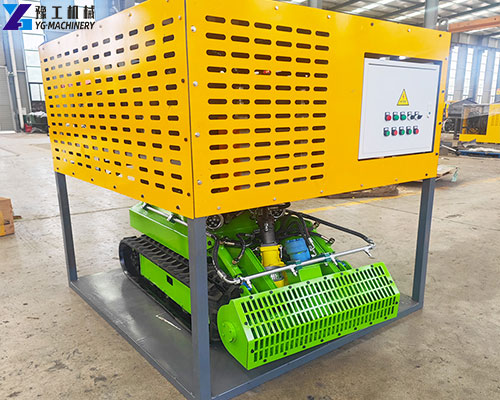
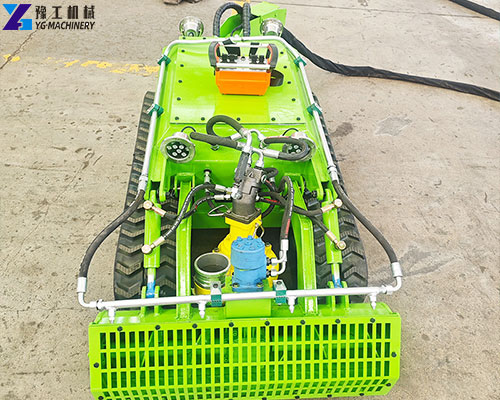
How a Dredging Robot Works?
- Descent and Positioning: The robot is lowered to the bottom of the water or tank using a lifting device. The operator starts the power and navigation system from a control console on shore, determining the initial position of the sludge cleaning robot.
- Suction and Propulsion: The robot moves underwater using tracks or a propeller. As it moves, the suction head at the front activates a built-in high-efficiency mud pump.
- Mud Delivery: The mud pump generates powerful suction, drawing in a mixture of sludge, water, and sediment, and pumping it to a dewatering or treatment system on shore via a connected pressure-resistant delivery hose (inside or outside the umbilical cable).
- Remote Monitoring and Control: The operator receives real-time video feeds from an underwater high-definition camera via the umbilical cable and, combined with sonar positioning data, remotely controls the robot to move accurately along a pre-set path, ensuring no sludge area is missed.
- Completion and Recovery: After the sludge removal task is completed, the robot is pulled out of the water by a lifting device for rinsing and maintenance.
Advantages of YG’s High-Efficiency Dredging Robot
- Reduced Safety Risks: Traditional manual cleaning of storage tanks and deep water pools requires workers to enter confined or hazardous areas, increasing the risk of accidents such as oxygen deficiency, slipping, and poisoning. YG’s dredging robot can be operated remotely, eliminating the need for operators to approach hazardous environments and fundamentally preventing safety hazards. This makes it particularly suitable for high-risk scenarios such as industrial storage tanks.
- Reduced Downtime Losses: Manual cleaning of large industrial storage tanks typically requires 3-7 days of downtime, while using the dredging robot only requires 1-2 days, reducing downtime by over 60%. For example, a chemical plant’s 500-cubic-meter storage tank, which required 5 days of downtime for manual cleaning, was completed in 2 days using the equipment, reducing downtime losses by 3 days and indirectly saving tens of thousands of yuan in economic benefits.
- Reduced Operating Costs: Manual cleaning requires 3-5 people, resulting in extremely high costs per cleaning operation; while the dredging robot requires only 1 operator, saving over 70% of cleaning costs in the long run.
- Improved Cleaning Quality: Manual cleaning of sludge in easily overlooked corners and crevices yields a pass rate of only 70%-80%. Equipped with a rotating scraper and a wide-angle camera, this equipment covers over 99% of the cleaning area, with sludge residue ≤1%. It is particularly suitable for industrial storage tanks in the food and pharmaceutical industries, where high cleanliness is required, and can be used as a professional industrial tank cleaning robot.
- Flexible Adaptability: Whether it’s a small community pool (under 100 cubic meters) or a large industrial storage tank (over 1000 cubic meters), there are corresponding models of dredging robots available. Parameters such as scraper hardness and suction pump power can also be customized according to customer needs, avoiding waste from using large equipment for small tasks or insufficient small equipment.
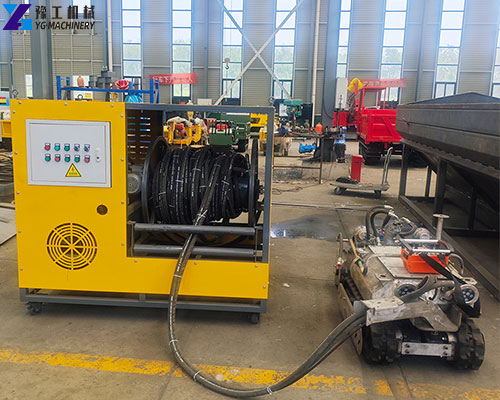
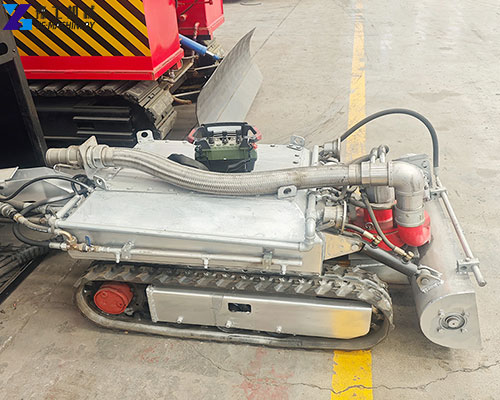
Case Studies of Dredging Robots in Different Applications
Case 1: A Chemical Plant in Houston, USA (Industrial Tank Cleaning)
- Customer Background: A chemical plant producing lubricating oil has five 500-cubic-meter raw material storage tanks, requiring cleaning every six months. Previously, manual cleaning was used, requiring a five-day shutdown and posing a risk of oxygen deficiency; a worker fainted in 2022.
- Requirements: A remotely operated, highly efficient cleaning system was needed to avoid manual entry into the tanks, while minimizing downtime and reducing safety risks.
- Results: After purchasing the YG dredging robot (medium-sized tracked, diesel-powered, food-grade material), two tanks were cleaned in just three days, reducing downtime by 40%; no workers were required to enter the tanks, completely eliminating safety hazards; after cleaning, the sludge residue in the tanks was ≤0.8%, improving the purity of the lubricating oil raw materials, and increasing the product qualification rate from 97% to 99.5%.
- Customer Testimonial: “The YG dredging robot completely solved our tank cleaning problem. It’s not only safe and efficient, but it also improves product quality. Before, every cleaning was nerve-wracking; now, one person can easily complete the task by operating the remote control. We plan to purchase two more units for cleaning other tanks.” — Mark Wilson, Production Manager, Chemical Plant.
Case 2: A Residential Community in Jakarta, Indonesia (Domestic Water Tank Maintenance)
- Client Background: A residential community with 500 households has two 100-cubic-meter domestic water tanks. Previously, cleaning was done annually, requiring a 3-day water outage. Even after manual cleaning, the water quality remained cloudy, leading to high resident complaints.
- Usage Requirements: A device was needed that could clean thoroughly without interrupting the water supply, minimizing disruption to residents’ water use, improving water quality, and reducing the complaint rate.
- Results: After using the YG dredging robot (small wheeled, lithium battery-powered, underwater operation type), underwater cleaning can be performed without water outages. Two pools were cleaned in one day without affecting the residents’ water supply. After cleaning, water transparency increased from 30cm to 150cm, bacteria count decreased by 80%, and resident complaints dropped from 5 per month to 0.
- Customer Review: “This dredging robot is perfect for maintaining the community’s pools. It doesn’t require water outages, cleans quickly and thoroughly, and residents no longer complain about water quality. It’s also easy to operate; the property electrician learned to use it in half an hour. It saves a lot on cleaning costs every year. Highly recommended!” — Suharto, the community property manager.
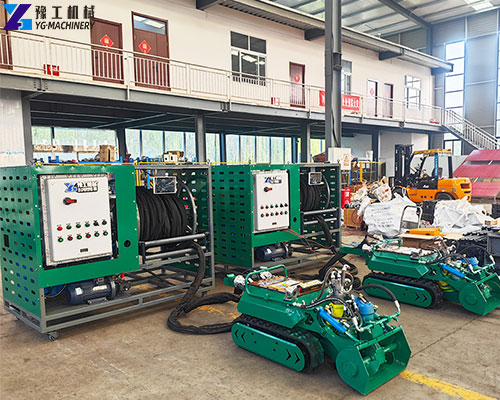
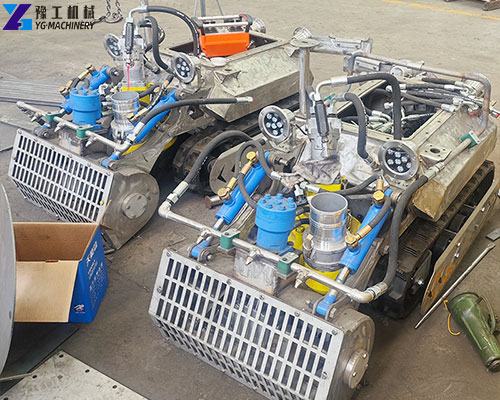
Dredge Remote Robot Price – YG Machinery Manufacturer
After you’ve gained a thorough understanding of the features of our YG dredge remote robot, we hope you realize that choosing us is more than just purchasing a high-tech machine. We offer long-term assurance for the safety and efficiency of your projects. We understand that underwater environments are challenging; the viscosity of sludge, water depth, and potential corrosive substances place extremely high demands on equipment. Therefore, we’ve invested significant effort to ensure the dredge remote robot operates stably in any harsh environment. Its waterproof sealing design, corrosion-resistant material selection, and high-strength structure have all undergone rigorous testing, making it safe for use in various conditions.
Our team will be your most reliable partner, always ready to support you. We know that even the most advanced equipment requires professional guidance and timely maintenance. Therefore, we provide comprehensive technical training to ensure your operators can easily master remote control techniques. We also have an efficient spare parts supply and technical consultation system. Whether you encounter difficulties removing special sludge while remotely controlling an industrial tank cleaning robot, or need to use it as a water tank cleaning robot to clean water tanks in remote areas, our professionals will respond quickly and provide assistance. Our goal is to ensure your sludge cleaning work is worry-free, allowing you to achieve maximum efficiency most safely.
Please contact our professional team immediately and tell us the details of the water body or tank environment that urgently needs cleaning. We will recommend the most suitable sludge cleaning robot configuration and provide a detailed quote and cost-benefit analysis. Click to contact us now.【WhatsApp/WeChat/Phone/Skype】+86 136 1385 6800
![]()

